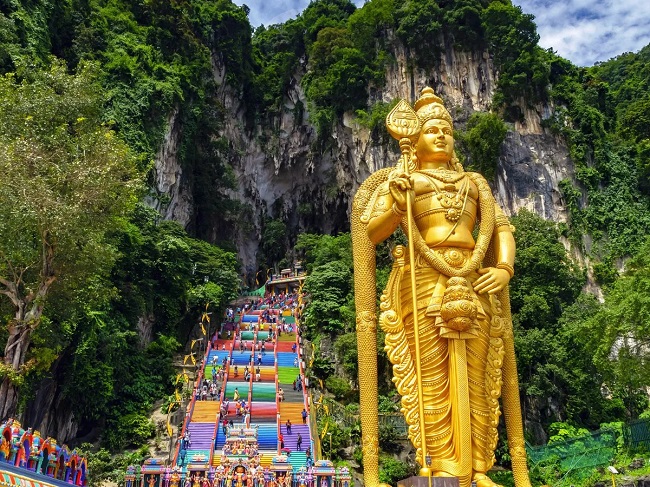Kuala Lumpur is a city of contrasts, where modernity meets tradition, and nowhere is this more evident than at the Batu Caves. This iconic Malaysian landmark blends natural wonder with religious significance, offering visitors a unique cultural experience.
In this comprehensive guide, we delve deep into everything you need to know about visiting the Batu Caves, from its history to travel tips and what you can expect to see.

Historical Significance of Batu Caves
Find out the historical significance of Batu caves:
Formation and Discovery
The Batu Caves are limestone hills featuring a series of caves and cave temples. They are estimated to be around 400 million years old.
Although these caves were used by the indigenous Temuan people, they gained wider recognition when they were discovered by American naturalist William Hornaday in 1878.
Religious Importance
The Batu Caves are primarily known for being a Hindu pilgrimage site, particularly during the Thaipusam festival. The caves house various Hindu shrines and are dedicated to Lord Murugan, the Hindu god of war.
What to See and Do
Some best places to explore:
The Golden Statue and the Steps
One of the first things you’ll notice upon arrival is the towering golden statue of Lord Murugan. Standing at 42.7 meters high, it’s the world’s tallest statue of this deity. Adjacent to the statue are the famous 272 steps that lead up to the Temple Cave.
Temple Cave
The largest and most significant of the Batu Caves is the Temple Cave, featuring ornate Hindu shrines. The natural light pouring in from the cave’s opening illuminates these intricate details, creating a surreal atmosphere.
Dark Cave
Apart from the religious aspects, Batu Caves also offers an adventurous experience through the Dark Cave. This section is home to various species of bats and rare cave-dwelling animals. Guided tours are available for those who want an educational adventure.
Cave Villa
Another must-visit is the Cave Villa, featuring two cave temples that house various statues and paintings depicting Hindu mythology. A nominal entrance fee is charged, and it’s worth every penny for the richness in art and culture you’ll witness.
Practical Information
Some practical Informations:
How to Get There
The Batu Caves are conveniently located just 13 km north of Kuala Lumpur and are accessible by train, bus, or taxi. The KTM Komuter train is the most cost-effective way, dropping you directly at the Batu Caves station.
Best Time to Visit
While the caves are open year-round, the best time to visit is during the Thaipusam festival, usually falling in late January or early February. However, it does get crowded, so if you prefer a quieter experience, plan accordingly.
Food and Amenities
There are several eateries near the entrance offering local dishes. Restrooms are also available, but it’s advisable to carry your own essentials like water and sunscreen.
Key Tips for Visitors
Some useful tips for your journey:
Dress Code
The Batu Caves are a religious site, so dressing modestly is crucial. Long trousers and shirts with sleeves are recommended.
Safety Precautions
Be mindful of the monkeys that roam the area; they can be aggressive when it comes to food and shiny objects.
Temple Cave
The Temple Cave, also known as Cathedral Cave due to its vaulted ceiling, is the most celebrated cave among the complex of Batu Caves.
To reach the entrance, visitors must climb the 272 steps alongside the awe-inspiring statue of Lord Murugan. Inside, you’ll find a sprawling cavern, well-lit by daylight streaming from the cave’s opening.
Art and Architecture
Within the Temple Cave, you’ll be mesmerized by the intricate Hindu shrines that dot the interior. Sculptures of various deities and murals depicting scenes from Hindu mythology adorn the walls.
The stalactites and stalagmites that formed over centuries serve as natural backdrops to these ornate shrines, making it a fascinating blend of natural history and human artistry.
Thaipusam Celebrations
If you’re lucky enough to visit during the Thaipusam festival, the cave transforms into a hub of vibrant festivities. Pilgrims often carry ‘kavadis,’ which are ornamental frameworks, up the steps as an act of devotion. The energy during this period is palpable, with rhythmic drumbeats and chants filling the air.
Conclusion
The Batu Caves are more than just a tourist attraction; they offer a deep dive into Malaysia’s rich cultural tapestry. From awe-inspiring natural formations to spiritual sanctuaries and adventurous expeditions, the Batu Caves have something for everyone.